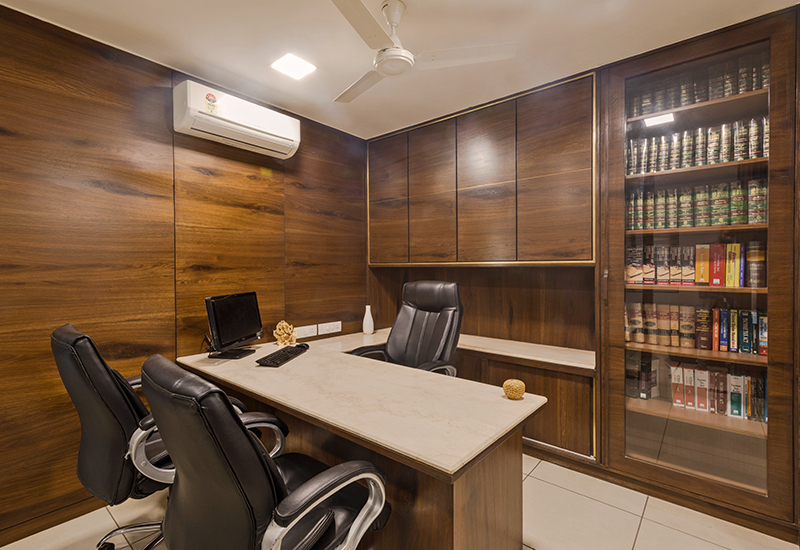A legal office’s interior design conveys a lot about the firm and its principles. In addition to making a good first impression on customers, a well-designed advocate’s office enhances the wellness and productivity of all employees. Professionalism and comfort, practicality and beauty, and tradition and contemporary demands are all balanced in a good design. These five crucial guidelines will help you create an advocate office interior design that genuinely reflects your legal identity and improves your working environment, whether you’re opening a new practice or remodelling a current one.
1. Strike the Right Balance between Professional and Welcoming
In addition to making clients feel at ease in potentially stressful situations, an advocate’s office should convey authority and reliability. Select a colour scheme that blends softer, cozier hues with more conventional legal hues like burgundy, navy blue, or forest green. Warmth and solidity are added by wood components. Think about utilizing art that is tasteful but not overpowering; landscapes, abstract pieces, or expertly taken photos are good choices. There should be cozy chairs in the reception area that are positioned to provide seclusion and shield talks from being overheard. The layout of your office should give clients the impression that they are in good hands because it is frequently their first physical encounter with your firm.
2. Prioritize Privacy and Confidentiality in Layout Planning
In the legal profession, confidentiality is crucial, and your office’s layout should reflect this. Place private consulting rooms away from busy areas while designing the layout. To keep private conversations from being overheard, make sure the walls separating conference rooms are adequately soundproofed. To hide talks, think about placing white noise machines in waiting rooms. Establish a distinct flow with safe access points between staff work areas and client-facing locations. Locations for storing documents should be private and safe. There should be areas in the layout for staff members to have spontaneous private discussions. You can show clients that their private information will be handled with the proper care and discretion by including privacy into every element of your design.
3. Design for Productivity and Work Efficiency
The effectiveness and caliber of work are greatly impacted by an advocate’s office design. Ample natural light at workplaces elevates mood and lessens eye strain when reviewing lengthy documents. Purchase ergonomic furniture to promote proper posture when working long hours. Establish distinct locations for various tasks, such as technological hubs for research and document creation, quiet areas for concentrated work, and collaborative areas for team discussions. When positioning printers, scanners, and filing systems, take information and document workflow into consideration. Research spaces and libraries should be comfortable enough for prolonged usage. There should be real relief from work-related stress in the kitchen and break rooms. Keep in mind that a desk that promotes physical comfort and minimizes needless interruptions will eventually result in higher-quality legal work.
4. Incorporate Technology Thoughtfully and Discreetly
Although technology plays a significant role in modern legal practice, it shouldn’t overpower your office’s professional ambiance. Create meeting spaces with integrated presenting features that allow displays to be concealed while not in use. To accommodate laptops and other devices without causing cable clutter, make sure the office has enough discrete power outlets. Think about cable management options that maintain connection while being discrete. For professional virtual meetings, video conferencing services should be provided in numerous rooms with suitable lighting and acoustics. Stations for wireless printing and scanning should be placed to maximize convenience without taking up too much space in the workspace. Technology should complement your work in a fluid manner and preserve the respectful environment that is crucial to an advocate’s workplace, feeling integrated rather than add-on.
5. Reflect Your Practice’s Identity and Values
Your office’s layout should convey your practice’s history and what makes you unique among advocates. Consider displaying historical details or antiques that relate to your proven expertise if your company has a lengthy history. Design decisions for more recent methods might highlight creativity and novel viewpoints. Relevant design elements can be used to gently highlight areas of specialization. For example, corporate legal offices may have more modern, business-oriented aesthetics, while environmental law practices may use sustainable materials and plants. With the right signage and design components, the welcome area should effectively convey your brand. Meeting spaces might be named after important court rulings or legal concepts that are pertinent to your line of work.
Conclusion
Beyond aesthetics, careful preparation is necessary to create the perfect advocate office interior design India via Officebanao. You may create a place that wows customers and helps your firm succeed by carefully weighing professionalism, secrecy, productivity, technological integration, and your individuality. Keep in mind that your workplace serves as an extension of your legal brand; make strategic investments for long-term benefits.
You can get in touch with them by email at [email protected] or via Whatsapp at 8929399141.

